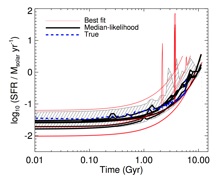Dan Smith’s Homepage


Position:
Senior Lecturer, University of Hertfordshire, UK
Research Interests:
radio continuum surveys, multi-wavelength galaxy SEDs, statistical studies of galaxies below the detection limit, galaxies in the far-infrared, high-z Lyman-alpha haloes, dust properties of starburst galaxies, galaxy cross-identification, reverberation mapping
Previous posts:
H-ATLAS PDRA, Nottingham University (2009 - 2011)
PDRA, Liverpool John Moores University (2007 - 2009)
Qualifications:
DPhil (Oxford, 2007)
MPhys (Oxford, 2004)
Department address:
The Centre for Astrophysics Research,
University of Hertfordshire,
College Lane,
Hatfield, Herts, AL10 9AB, UK
Telephone:
01707 285189
electronic mail:
daniel.j.b.smith _at_ gmail.com
d.j.b.smith _at_ herts.ac.uk
ORCID:
“A complete distribution of redshifts for sub-millimetre galaxies in the SCUBA-2 Cosmology Legacy Survey UDS field”
D.J.B. Smith et al., 2017, arXiv:1707.00694
ABSTRACT:
“Sub-milllimetre galaxies (SMGs) are some of the most luminous star-forming galaxies in the Universe, however their properties remain hard to determine due to the difficulty of identifying their optical\slash near-infrared counterparts. One of the key steps to determining the nature of SMGs is measuring a redshift distribution representative of the whole population. We do this by applying statistical techniques to a sample of 761 850μm sources from the SCUBA-2 Cosmology Legacy Survey observations of the UKIDSS Ultra-Deep Survey (UDS) Field. We detect excess galaxies around >98.4 per cent of the 850μm positions in the deep UDS catalogue, giving us the first 850μm selected sample to have virtually complete optical\slash near-infrared redshift information. Under the reasonable assumption that the redshifts of the excess galaxies are representative of the SMGs themselves, we derive a median SMG redshift of z=2.05±0.03, with 68 per cent of SMGs residing between 1.07<z<3.06. We find an average of 1.52±0.09 excess K-band galaxies within 12 arc sec of an 850μm position, with an average stellar mass of 2.2±0.1×1010 M⊙. While the vast majority of excess galaxies are star-forming, 8.0±2.1 per cent have passive rest-frame colours, and are therefore unlikely to be detected at sub-millimetre wavelengths even in deep interferometry. We show that brighter SMGs lie at higher redshifts, and use our SMG redshift distribution -- along with the assumption of a universal far-infrared SED -- to estimate that SMGs contribute around 30 per cent of the cosmic star formation rate density between 0.5<z<5.0.”
To read the full version, click through to arXiv.org, or from MNRAS here.
“The WEAVE-LOFAR Survey”
D.J.B. Smith et al., 2016, arXiv:1611.02706
ABSTRACT:
“In these proceedings we highlight the primary scientific goals and design of the WEAVE-LOFAR survey, which will use the new WEAVE spectrograph on the 4.2m William Herschel Telescope to provide the primary source of spectroscopic information for the LOFAR Surveys Key Science Project. Beginning in 2018, WEAVE-LOFAR will generate more than 10^6 R=5000 365-960 nm spectra of low-frequency selected radio sources, across three tiers designed to efficiently sample the redshift-luminosity plane, and produce a data set of enormous legacy value. The radio frequency selection, combined with the high multiplex and throughput of the WEAVE spectrograph, make obtaining redshifts in this way very efficient, and we expect that the redshift success rate will approach 100 per cent at z < 1. This unprecedented spectroscopic sample - which will be complemented by an integral field component - will be transformational in key areas, including studying the star formation history of the Universe, the role of accretion and AGN-driven feedback, properties of the epoch of reionisation, cosmology, cluster haloes and relics, as well as the nature of radio galaxies and protoclusters. Each topic will be addressed in unprecedented detail, and with the most reliable source classifications and redshift information in existence.”
The paper can be found by clicking through to arXiv.org.
“Deriving star formation histories from photometry using energy balance spectral energy distribution modelling”
D.J.B. Smith and C.C. Hayward, 2015, MNRAS, 453, 1597
ABSTRACT:
“Panchromatic spectral energy distribution (SED) fitting is a critical tool for determining the physical properties of distant galaxies, such as their stellar mass and star formation rate. One widely used method is the publicly available MAGPHYS code. We build on our previous analysis (Hayward & Smith 2015) by presenting some modifications which enable MAGPHYS to automatically estimate galaxy star formation histories (SFHs), including uncertainties, based on ultra-violet to far-infrared photometry. We use state-of-the art synthetic photometry derived by performing three-dimensional dust radiative transfer on hydrodynamic simulations of isolated disc and merging galaxies to test how well the modified MAGPHYS is able to recover SFHs under idealised conditions, where the true SFH is known. We find that while the SFH of the model with the best fit to the synthetic photometry is a poor representation of the true SFH (showing large variations with the line-of-sight to the galaxy and spurious bursts of star formation), median-likelihood SFHs generated by marginalising over the default MAGPHYS libraries produce robust estimates of the smoothly-varying isolated disk simulation SFHs. This preference for the median-likelihood SFH is quantitatively underlined by our estimates of χ2SFH (analogous to the χ2 goodness-of-fit estimator) and ΔM/M (the integrated absolute mass discrepancy between the model and true SFH) that strongly prefer the median-likelihood SFHs over those that best fit the UV-to-far-IR photometry. In contrast, we are unable to derive a good estimate of the SFH for the merger simulations (either best-fit or median-likelihood) despite being able to obtain a reasonable fit to the simulated photometry, likely because the analytic SFHs with bursts superposed in the standard MAGPHYS library are insufficiently general/realistic.”
The paper can be found by clicking here, or on Arxiv.org.
“The temperature dependence of the far-infrared-radio correlation in the Herschel-ATLAS”
D.J.B. Smith et al., 2014, MNRAS, 445, 2232
ABSTRACT:
“We use 10 387 galaxies from the Herschel Astrophysical TeraHertz Large Area Survey (H-ATLAS) to probe the far-infrared radio correlation (FIRC) of star-forming galaxies as a function of redshift, wavelength, and effective dust temperature. All of the sources in our 250 μm-selected sample have spectroscopic redshifts, as well as 1.4 GHz flux density estimates measured from the Faint Images of the Radio Sky at Twenty centimetres (FIRST) survey. This enables us to study not only individual sources, but also the average properties of the 250 μm-selected population using median stacking techniques. We find that individual sources detected at ≥5σ in both the H-ATLAS and FIRST data have logarithmic flux ratios (i.e. FIRC qλ parameters) consistent with previous studies of the FIRC. In contrast, the stacked values show larger qλ, suggesting excess far-IR flux density/luminosity in 250 μm-selected sources above what has been seen in previous analyses. In addition, we find evidence that 250 μm sources with warm dust spectral energy distributions have a larger 1.4 GHz luminosity than the cooler sources in our sample. Though we find no evidence for redshift evolution of the monochromatic FIRC, our analysis reveals significant temperature dependence. Whilst the FIRC is reasonably constant with temperature at 100 μm, we find increasing inverse correlation with temperature as we probe longer PACS and SPIRE wavelengths. These results may have important implications for the use of monochromatic dust luminosity as a star formation rate indicator in star-forming galaxies, and in the future, for using radio data to determine galaxy star formation rates.”
The paper can also be found on the ArXiv preprint server.
“Should we believe the results of ultraviolet-millimetre galaxy spectral energy distribution modelling?”
C.C. Hayward and D.J.B. Smith, 2015, MNRAS, 446, 1512
ABSTRACT:
“Galaxy spectral energy distribution (SED) modelling is a powerful tool, but constraining how well it is able to infer the true values for galaxy properties (e.g. the star formation rate) is difficult because independent determinations are often not available. However, galaxy simulations can provide a means of testing SED modelling techniques. Here, we present a numerical experiment in which we apply the SED modelling code MAGPHYS to ultraviolet-millimetre synthetic photometry generated from hydrodynamical simulations of an isolated disc galaxy and a major galaxy merger by performing three-dimensional dust radiative transfer. We compare the properties inferred from the SED modelling with the true values and find that MAGPHYS recovers most physical parameters of the simulated galaxies well. In particular, it recovers consistent parameters irrespective of the viewing angle, with smoothly varying results for neighbouring time steps of the simulation, even though each viewing angle and time step is modelled independently. The notable exception to this rule occurs when we use a Small Magellanic Cloud-type intrinsic dust extinction curve in the radiative transfer calculations. In this case, the two-component dust model used by MAGPHYS is unable to effectively correct for the attenuation of the simulated galaxies, which leads to potentially significant errors (although we obtain only marginally acceptable fits in this case). Overall, our results give confidence in the ability of SED modelling to infer physical properties of galaxies, albeit with some caveats.”
The paper can also be found on the ArXiv preprint server.

Recent published highlights:
I am a lecturer at the University of Hertfordshire working primarily on galaxy formation and evolution. I study galaxies at redshifts spanning most of cosmic history, and across practically the whole electromagnetic spectrum (but particularly at far-infrared, sub-millimetre and radio wavelengths), to answer questions about what drives their evolution. I am also interested in using state-of-the-art simulations to test observational techniques, and in large spectroscopic surveys of radio sources (in particular leading the WEAVE-LOFAR survey, which is due to begin in 2018). I am currently making my first foray into time-domain astrophysics; watch this space!
For Masters and PhD projects I am currently offering, visit the Centre for Astrophysics Research webpages.



The plot on the right, taken from Smith & Hayward (2015), shows star formation histories (SFHs) estimated using a modified version of the MAGPHYS code, for a simulated disk galaxy whose true SFH (dashed blue line) is known. The best-fit SFHs derived from seven different lines of sight (in red) are unreliable and contain spurious bursts of star formation, whereas the median-likelihood SFHs (in black, with uncertainties shown by the grey shaded region) are more reliable.




